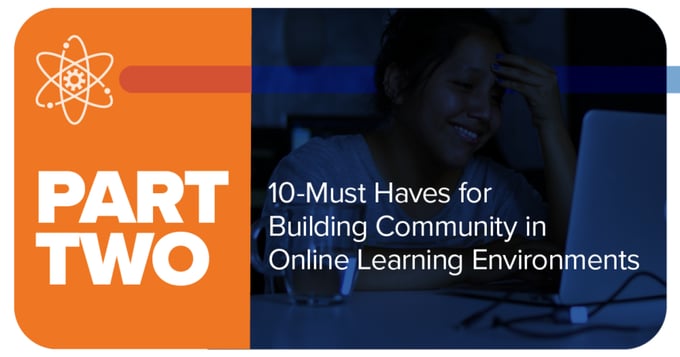Dr. Kathryn Kennedy has over 15 years of experience in online, blended, and digital learning in PreK-12, higher education, and beyond. Her work is focused at the intersection of research, practice, and policy. She owns and operates her own consulting firm that is currently helping inform PLTW’s current and future teaching and learning experiences.
Whether you are engaging online, face-to-face, or somewhere in between, community building is not only an art, it is a vital ingredient for cultivating meaningful learning environments. Specifically in an online learning environment like the one we are creating for PLTW Core Training this summer, building community is even more critical because you’re not physically in the same location as the rest of your fellow learners and training facilitators. To that end, we have built the PLTW Core Training experience upon a foundation focused on community building.
Of what does that foundation consist, you ask? The foundation consists of 10 must-have components, that we will share in this two-part series. To read components 1-5, click here for Part One.
6. Design with the principles of meaningful learning in mind. Jonassen’s meaningful learning is made up of five research-based principles, including collaborative, active, goal-directed, authentic, and reflective. We’ve talked a lot about the need for collaborative learning already, so we will move on to active. Active means that learners should be actively learning rather than passively (sit and get) learning, whether participating with the whole group in an activity, or working collaboratively with a small group or partner, learners should be actively creating new knowledge through the activities they are in. Learning should also be goal-directed so that there is specific intention behind all the activities, goals, and assessments. All the activities, goals, and assessments should be authentic as well, meaning they should be tied to real-world problems, solutions, and applications, similar to PLTW’s APB approach. And finally, learning should always be reflective, providing learners time to understand what they are learning and how it relates to their prior knowledge and how they can apply and transfer that knowledge in new ways in varying situations moving forward.
7. Intentionally integrate opportunities for interaction within the learning process. PLTW training experiences incorporate Moore’s interaction theory, which provides opportunities for learners to interact with the content, with other participants, with their facilitator, as well as with a variety of systems and field-based experts, all of which bring varying perspectives and representations of knowledge to the learner in the community.
8. Provide multiple layers of support. Facilitators and learners alike can benefit from a built-in support structure in their learning community. Supporting learners during their experience is critical, specifically to mitigating feelings of transactional distance. What is transactional distance? It is the psychological distance that learners can feel in an online learning experience when there is little to no dialogue, little to no structure, and little to no learner autonomy. Increasing dialogue (interaction, collaboration - which we talked about in a lot of places above already), increasing structure (which we talked about in #1), and increasing learner autonomy (which we talked about in #3) can rid an online learning experience of transactional distance. Additionally, adding layers of support like technology support, such as the Online Learning Specialists that we are incorporating in PLTW Core Training experiences this summer, can help learners feel supported. Facilitators can also host office hours to not only help with content questions but also to help check in on learners’ well-being. Wellness checks model social emotional learning, which is critical not only during times of global pandemic but at all times. Humanizing the learning experience is key, especially to help dispel the myth that learning with technology and any online learning experience is devoid of human interaction, which can be alleviated with intentional design that purposefully and meaningfully adds in the human components of interaction, collaboration, as well as relationship and community building.
9. Implement assessments that have real-word connections. Assessments should be authentic and applicable for learners. Learners should demonstrate understanding by connecting what they learned directly to how it can be applied in the real world. Assessments should be open-ended challenges that give learners an opportunity to make a difference in our global society in creative, inventive, and informed ways.
10. Ensure equity, access, and inclusion to mitigate opportunity gaps. Learning in any community should not be a function of location, race, class, socioeconomic status. Design should be mindful and include but not be limited to culturally responsive and inclusive approaches to mitigate opportunity gaps.
Using these must-have, research-based best practices to inform design and development work is critical to ensure a thriving community in online learning environments. Launching in just a few short weeks, PLTW Core Training incorporates these 10 must-haves. Our team has spent March, April, and May working diligently to translate the face-to-face PLTW Core Training into online learning experiences.
PLTW’s dedication and commitment to offering high-quality, dynamic, interactive, and collaborative experiences through its many face-to-face professional learning opportunities is being maintained as we transition this learning online. To be clear, our transition to online learning is less about the technology and more about the relationship and community building that we will continue to engage in with our learners in this new learning environment. We are so excited to welcome you to the trainings, and we look forward to seeing you there!
Jonassen, D., et al. (2008). Meaningful Learning with Technology (3rd ed.) Upper Saddle River, NJ: Pearson Educaton.
Moore, M. G. (2013). Chapter 2. Handbook of Distance Education (3rd ed.). New York: Lawrence Erlbaum Associates.
PLTW’s blog intends to serve as a forum for ideas and perspectives from across our network. The opinions expressed are those of each guest author.


